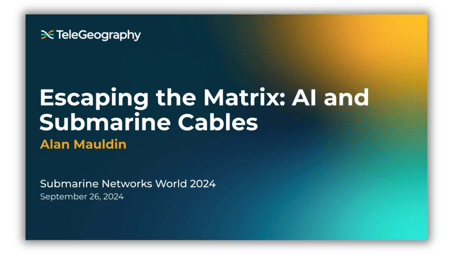We are now moving from sci-fi to reality with the launch of many AI services that are poised to transform industries and reshape our daily lives.
While data centers are expanding rapidly to support AI requirements, there is less clarity on how AI might impact long-haul network infrastructure, especially submarine cables.
This is exactly what I delved into during my keynote at Submarine Networks World 2024.
In this presentation, I looked at three big questions:
1. How big are AI training data sets and models?
To understand AI's potential impact on submarine cables, we must consider the sheer size of training data and models.
I was curious to understand just how big the training data and models are in terms of gigabytes, instead of the more obscure metrics used in the AI world like parameters or tokens. After all, this data is the raw material that could be carried around the globe on submarine cables.
2. How will AI impact demand for submarine cable bandwidth?
Over the last few years, I've been asking people how AI might shape the demand of submarine cable bandwidth. I presented some results of this non-scientific, fake survey in the chart below.
.png?width=1000&height=563&name=snw24_matrix_alan.pptx%20(2).png)
Even with no definitive answer to this question, it is worth digging into what factors may play a role.
Two words: location matters.
A model may require pulling training data from sources located all over the world, or it could be relying purely on a data set already stored locally. Model training and inference (using an AI model) could occur within the same city, or the model may be distributed globally across multiple data centers.
And that's just the tip of the iceberg.
Factors such as data size, model training frequency, power availability, data sovereignty laws, inference latency, and on-device inference will also influence bandwidth requirements.
3. Is there an AI-fueled bubble in new submarine cables?
Many veterans of the telecom industry will recall the submarine cable investment bubble (and subsequent meltdown) in the late 1990s/early 2000s. Is the current level of investment similar to what happened a quarter of a century ago?
While hundreds of billions of dollars are flooding into GPUs, data centers, and power generation, the investment into new cables is more modest.
.png?width=1000&height=563&name=snw24_matrix_alan.pptx%20(3).png)
Moving forward
I closed with a look at some factors to keep an eye on as the AI revolution progresses. In particular, the location of future AI factories is important. Will these be in areas that are unconnected or underserved by submarine cables?

More Data This Way 👇
You can find my full 2024 Submarine Networks World presentation over here.
Download the slides. Free your mind.
Alan Mauldin
Alan Mauldin is a Research Director at TeleGeography. He manages the company’s infrastructure research group, focusing primarily on submarine cables, terrestrial networks, international Internet infrastructure, and bandwidth demand modeling. He also advises clients with due diligence analysis, feasibility studies, and business plan development for projects around the world. Alan speaks frequently about the global network industry at a wide range of conferences, including PTC, Submarine Networks World, and SubOptic.




.png?width=1000&height=563&name=snw24_matrix_alan.pptx%20(4).png)
